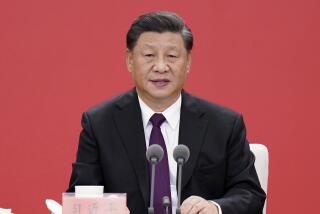End the Fairy-Tale Reporting of Tibet
- Share via
At long last, we are seeing a change in media coverage of Tibet, and it’s way overdue. In the past, the situation in Tibet has been grossly oversimplified. Journalists presented it as a tale of good guys (Tibetans) and bad guys (Chinese) clearly delineated, a story with fairy tale appeal but little basis in reality. As a result, U.S. foreign policy has been handicapped by a voting and vocal public that has never heard the whole story.
To be fair, reporting has been hobbled by Chinese restrictions on foreign journalists wanting to visit Tibet. In the past, only a very few reporters were allowed in, invariably accompanied by officials who followed their every move, preventing them from speaking to ordinary Tibetans. News stories therefore had to be concocted from the hearsay of tourists, many of whom are admirers of the Dalai Lama--who was in the U.S. last week--and from reports published by the Tibet Information Network, which is strongly anti-Beijing.
Weighing in for the Chinese side are nauseating, unbelievable stories put forth by the New China News Agency and other state news organs--stories about former serfs making it big in New China and thanking the Communist Party for their liberation. Articles are heavy in misleading and false statistics and riddled with English malapropisms. “Ex-Serf Strike a Rich Today” says a headline in the March 1999 issue of the magazine China’s Tibet. Small wonder that journalists are hard put to unearth nuggets of truth from the avalanche of clumsy, politically motivated rhetoric. It is far easier to dismiss Chinese publications out of hand.
The result has been that the foreign press has tended to act like a mouthpiece of the Tibetan government-in-exile, an organization whose overriding concern is, understandably, to regain of their lost nation.
Uncritical acceptance of flawed and biased information has been routine in American newspapers. Journalists have read the poorly researched work of other journalists, written more of the same and built up a demand for China-bashing stories. Such reporting sells newspapers by staying in the public’s comfort zone, shielding us from moral ambiguity; but it is mighty poor journalism.
As president of a nongovernmental organization that brings foreign aid into Tibet, I have seen how Tibetans are hurt by the information blackout. When I try to raise money for repair of Buddhist monasteries, potential donors cite widely reported figures of 4,000, 5,000 or 6,000 (take your pick) monasteries razed by the Chinese, and are reluctant to believe there is anything left to repair. When I solicit donations on behalf of schools in Tibet, people object erroneously that schools do not teach Tibetan language and are therefore instruments of the Chinese policy of cultural annihilation. When I ran an art conservation program that rescued some rare and endangered Tibetan murals, some felt that because the Chinese government allowed this project, there must be something wrong with it, and advised one of my volunteer workers not to participate.
The American public has been conditioned to believe that the Chinese are utterly opposed to any sort of Tibetan cultural or economic advancement. Accurate reporting would show that this is simply not the case.
At last, the era of Tibet-as-a-fairy-tale seems to be ending. In the past few years, the myth of “Paradise Lost” has been undermined if not exploded by a spate of new books by Tibetans and others critically examining their old society and the Dalai Lama’s once-unassailable Dharamsala government. Now reporters are getting into Tibet and staying there long enough to dig deeply. The result is a balanced picture of a complex and evolving region.
The Tibet issue is a thorn in the side of fragile Sino-American relations, which are pivotal to peace and security in the world at large. These are not small stakes. Let’s hope that this new era of objective journalism in Tibet leads to a breakthrough in the deadlock between the Dalai Lama and Beijing. I believe that Tibetans, Chinese and Americans will all benefit from it.
More to Read
Sign up for Essential California
The most important California stories and recommendations in your inbox every morning.
You may occasionally receive promotional content from the Los Angeles Times.













